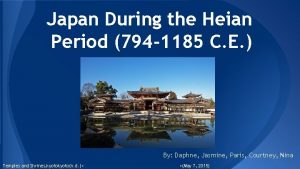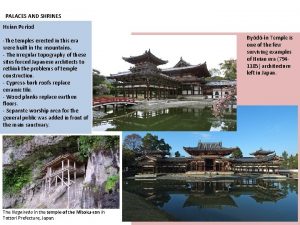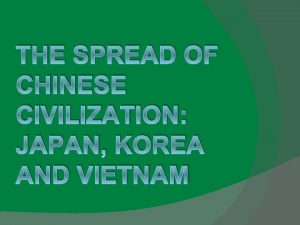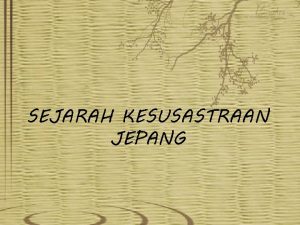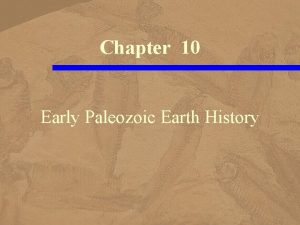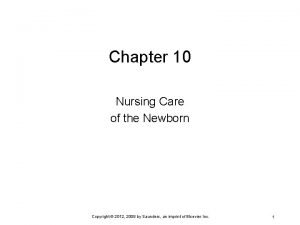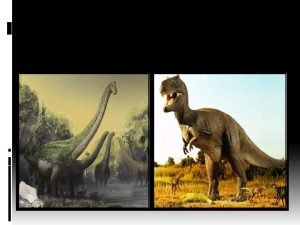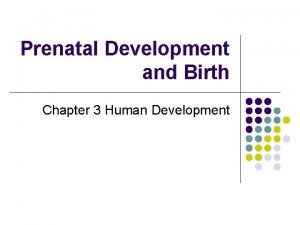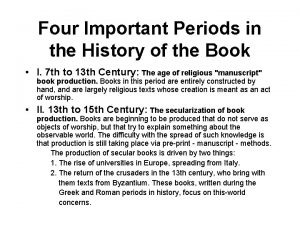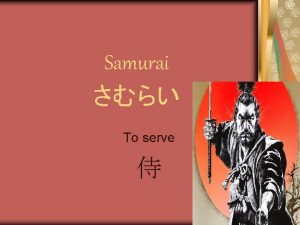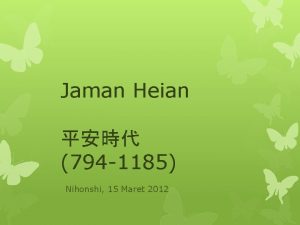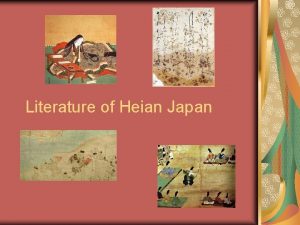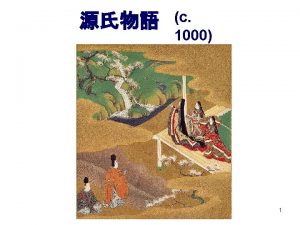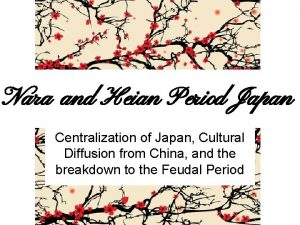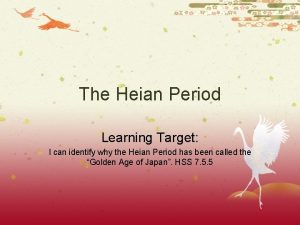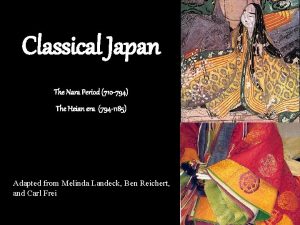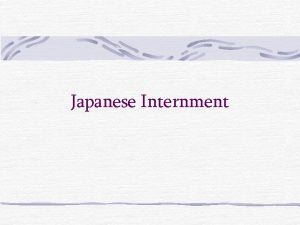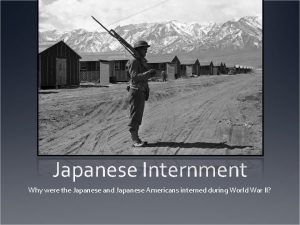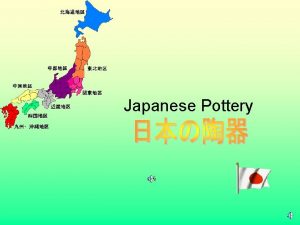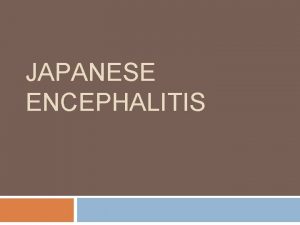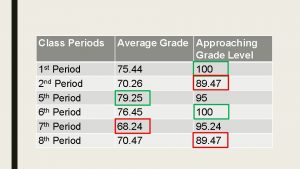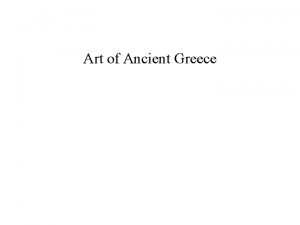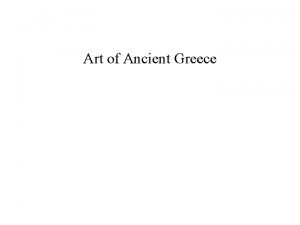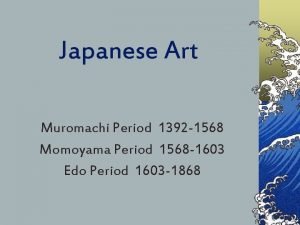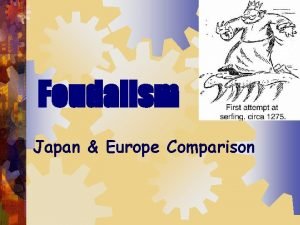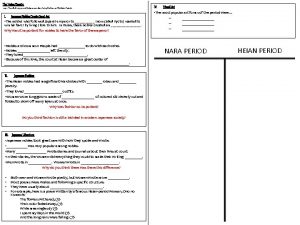Japanese Periods Major Japanese Periods Heian period 794









































- Slides: 41

Japanese Periods Major Japanese Periods: Heian period: 794 – 1185 CE Heian Period: 800 CE – 1200 CE Kamakura Shogunate: 1185 – 1333 CE Fragmentation (weak shogunate): 1333 1603 CE Tokugawa Period: 1600 - 1850 Tokugawa Meiji Shogunate: 1603 - 1868 CE Meiji Japan: 1868 – 1945 CE Current government: 1945 - Today

600 CE – 1450 CE

Early Japan • Early Japan = organized around family-based clans that controlled certain regions • Each family descended from a different common ancestor • Each clan worshipped this ancestor as a special kami = spirit • Shinto = belief that kamis live within all people, animals, and nature

Modeling after China • As these clans began to unify into a Japanese “state”, Japan began to model itself after China in some ways • Elements adopted from China: • • • Buddhism and Confucianism Chinese-style court rituals and court rankings Chinese calendar Chinese-based taxation systems Chinese-style law codes and government departments Chinese-style writing system

Modeling after China • Unlike Korea and Vietnam – Japan is physically separated from China • Result = Japan was never successfully invaded or conquered by China • Result = any Chinese cultural elements adopted by Japan = 100% voluntary • Result = Japan will retain a very unique & distinct culture

Heian Japan • Heian Period = 800 – 1200 • Capital of Japan = Heian (later renamed Kyoto) • Focus of this period = pursuit of beauty • Japanese influenced by Chinese art, literature, calligraphy, poetry, etc. • Spent hours each day writing letters and poems • Rise of literature ex: The Tale of Genji

Heian Japan • In their “search for beauty” during the Heian period, governmental responsibilities were neglected • Centralized government broke down • Emperor lost power • Gave way to “feudal” Japan

Feudal Japan Hierarchy Shoguns = generals and powerful lords Most political and military power Code of Bushido = samurai code of honor Mikado = emperor Very little power; figurehead Daimyos = local lords Owned estates Had private armies Always fighting each other Samurai = warriors Loose-fitting armor Fought with swords AND on horseback with bows & arrows Peasants worked on the land; paid heavy taxes; received protection in return Seppuku = ritualistic suicide belly -slashing

Japanese Women • Escaped the more oppressive features of Chinese Confucian culture; could: • • Inherit property Live apart from their husbands Get divorced easily Remarry if widowed or divorced

1450 - 1750

Japan and the Europeans • When European merchants first arrived in Japan (1500 s) Japan = tied down with interior conflicts between competing daimyos (feudal lords), each with his own band of samurai • Result = it was easy for the Europeans to stay there • European ideas taken by the Japanese = shipbuilding skills, military technology, geographic knowledge, commercial opportunities, and religious ideas

The Tokugawa Shogunate • 1600 – 1850 = Japan unified and ruled by the Tokugawa Shogunate • Shogun = military ruler • Emperor at this time = basically powerless • Chief task = prevent return of civil war among the 260 daimyo • Feudal lords each with their own band of samurai • Shoguns brought peace to Japan for more than 2 centuries Lineage of the Tokugawa Shoguns

Tokugawa and the Europeans • Early 1600 s = Japan unified politically by military commanders • Now led by the lead commander = shogun • From the Tokugawa clan • Set up the Tokugawa Shogunate • Shoguns began to see Europeans as a threat to Japan’s new unity Tokugawa Ieyasu

Japan and the Europeans • Result = Japan did the following: • Expelled Christian missionaries • Violently suppressed the practice of Christianity • Included: Torture and execution of missionaries and converts • Forbade Japanese people from travelling abroad • Banned European traders from entering Japan • Result = Japan became isolated from the world of European commerce for 2 centuries (1650 -1850) Painting of Japanese authorities • Maintained trading ties with only China and Korea

The Tokugawa Background • System devised to keep the daimyo in check = “attendance-in-turn” • Daimyo required to build second homes in Edo (the capital) and live there every other year • When they left for their rural residences, their families had to stay behind as hostages • Daimyo still enjoyed independence in their own domains own law codes, militaries, tax systems, currencies, etc. • Japan was peaceful…but not truly unified “A Daimyo Paying a State Visit”

Silver and Japan • Japan put its silvergenerated profits to good use: Procession of Japanese shoguns in 17 th century • Shoguns used it to defeat rival feudal lords and unify Japan • Shoguns worked with merchant class to develop a market-based economy • Invested in agricultural and industrial enterprises • Protected and renewed Japan’s dwindling forests

Silver and Japan • Simultaneously = millions of families (in 18 th century) took steps to have fewer children • Results for Japan = slowing of population growth; prevention of ecological crisis; bustling, commercialized economy • Laid the groundwork for Japan’s Industrial Revolution in the 19 th century

1750 - 1900

Economic and Urban Changes • Centuries of peace allowed for economic growth, commercialization, and urban development • By 1750 = most people in Japan lived in large towns or cities • Emerging capitalism markets linked urban and rural areas • Encouragement of education = produced a very literate population Japanese Teahouse during the Edo Period

Economic and Urban Changes • Merchants = thrived in this commercial economy • Had wealth, but no status still considered the lowest in society according to the Confucian hierarchy • Many daimyo and samurai = found it necessary to borrow money from these “social inferiors” Japanese Merchants • Had high status, but no wealth

Economic and Urban Changes • Peasants supposed to: devote themselves to farming, live simply, and avoid luxuries • Many peasants ignored this “law” and moved to the cities to become artisans or merchants • Ignored their “status” and imitated their superiors example: used umbrellas instead of straw hats in the rain Japanese Peasants

The Tokugawa Shogunate: Losing Control • In addition to these economic and social changes, other factors contributed to Shogunate’s loss of control in the early 1800 s: Japanese Peasant Infantry • Corrupt and harsh officials • Severe famine in the 1830 s that the shogunate could not deal with effectively • Expressions of frustration from the poor peasant uprisings and urban riots

American Intrusion of Japan • Since the early 1600 s = Japan had deliberately limited its contact with the West • • Expulsion of European missionaries Harsh suppression of Christianity Japanese forbidden from leaving Only 1 port where the Dutch were allowed to trade • Early 1800 s = European countries and the U. S. were “knocking on Japan’s door” to persuade them to reopen contact with the West • All were turned away • Even shipwrecked sailors were jailed or executed Nagasaki Bay Dutch Port during Japanese Isolationism

American Intrusion of Japan • 1853 = U. S. Commodore Matthew Perry “opened” Japan • Commodore Perry demanded: • Humane treatment of castaways • Right of American ships to refuel and buy supplies • Opening of Japanese ports for trade • He was authorized to use force if necessary, but Commodore Perry approached the Japanese with gifts and a white flag Commodore Perry Lands in Japan • War was avoided

American Intrusion of Japan • Japan agreed to a series of unequal treaties with the U. S. and different Western powers • They knew what happened to China when it resisted European demands – did not want that outcome • Results of this decision: • Loss of support for the ruling shogunate • Brief civil war • 1868 = political takeover by a group of samurai from southern Japan called the Meiji Restoration “Eejanaika” Dancing on the Eve of the Meiji Restoration

The Meiji Restoration • Goals of the Meiji Restoration: • Save Japan from foreign domination • Transform and modernize Japanese society by drawing upon Western achievements and ideas • This transformation becomes possible due to: • No massive violence or destruction in Japan as in China (Taiping Rebellion) • Less pressure from Western powers than in China and the Ottoman Empire Emperor Meiji (1867 -1912) • Japan = less sought after by Europeans because its location wasn’t very strategic and it didn’t have as many people or riches • U. S. ambitions in the Pacific = deflected by the Civil War and its aftermath

Modernization Japanese Style • First task = true national unity = required an attack on the power and privileges of the daimyo and samurai • Ended the semi-independent domains of the daimyo • Replaced with governors appointed by and responsible to the national government • National government (not local authorities) now: collected taxes and raised a national army Japanese Color Woodblock Print of Meiji Dignitaries (1877)

Modernization Japanese Style • Development of a nationwide economy • Dismantling of old Confucianbased social order with its special privileges for certain classes • All Japanese became legally equal • Official missions to Europe and the U. S. to learn about the West A Meeting of Japan, China, and the West

Modernization Japanese Style • Japan borrowed many ideas from the West and combined these foreign elements with Japanese elements • Goal = modernize and maintain unique culture • Ex: Constitution of 1889 included a parliament, political parties and democratic ideals, BUT the constitution was presented as a gift from a scared emperor descended from the Sun Goddess • Ex: Modern education system included Confucian principles The Meiji Emperor Proclaiming the Meiji Constitution in 1889

Japan’s State-Guided Industrialization Program • Government set up a number of enterprises and later sold them to private investors • Used own resources when industrializing • Became a major exporter of textiles and was able to produce its own manufactured goods Painting of a Western-Style Japanese Factory from the 1880 s

Japan’s State-Guided Industrialization Program • The Japanese government also: • Built railroads • Created a postal system • Established a national currency • Set up a national banking system Japanese Steam Train (1872)

Social Results of Industrialization Female Workers in a Japanese Bamboo Basket Factory (1904) • Many peasant families slid into poverty taxed too much to pay for Japan’s modernization • Protests with attacks on government offices and bankers’ homes • Low pay and terrible working conditions for factory workers (mainly women)

Social Results of Industrialization • Anarchist and socialist ideas developed among intellectuals • Efforts to create unions and organize strikes met with harsh opposition

1900 - Present

Japan’s Experience with Europe • Very different than China and the Ottoman Empire • Did not succumb to Western domination • Was able to turn itself into a powerful, modern, united, industrialized nation • Joined the “imperialism bandwagon” and created its own East Asian empire

Japan and the World • Western powers revised the unequal treaties they had with Japan • Anglo-Japanese Treaty (1902) = acknowledged Japan as an equal player among the “Great Powers” of the world • Became a military competitor and imperialist power in East Asia

Japanese Imperialism • Japan led successful wars against: • China (1894 -1895) gained colonial control of Taiwan and Korea • Russia (1904 -1905) gained a territorial foothold in Manchuria • Japan = first Asian state to defeat a major European power

Japanese Empire 1942

The Occupation • 1945 - 1952 • Supreme Commander of the Allied Powers (SCAP) - General Douglas Mac. Arthur • Two main tasks: • demilitarization • democratization

Demilitarization • Purged almost all wartime officers and politicians • Disbanded almost all militaristic associations and parties • Prosecuted almost all war criminals • The issue of Yasukuni Shrine • Dismantled almost all war industries

The "Peace Clause" • Article 9 in the 1947 constitution: • “the Japanese people forever renounce war as a sovereign right of the nation and the threat or use of force as means of settling international disputes • “land, sea, and air forces, as well as other war potential, will never be maintained”
 Heian period social structure
Heian period social structure Kalio jododas
Kalio jododas Worx landroid wg794
Worx landroid wg794 Spread of china's literature to heian japan and korea
Spread of china's literature to heian japan and korea Kesusastraan jepang zaman modern
Kesusastraan jepang zaman modern Heian court hierarchy
Heian court hierarchy Heian-kyo the heart of japan's golden age
Heian-kyo the heart of japan's golden age Grade 7 background
Grade 7 background Medieval japan art
Medieval japan art Characteristics of early filipino music
Characteristics of early filipino music Ordovician period major events
Ordovician period major events Music of classical period 1750 to 1820
Music of classical period 1750 to 1820 Trustee period and royal period
Trustee period and royal period When is the relative refractory period
When is the relative refractory period Non-metal halogen family atomic mass 35?
Non-metal halogen family atomic mass 35? Bc va ad
Bc va ad Critical period vs sensitive period
Critical period vs sensitive period Critical period vs sensitive period
Critical period vs sensitive period Youth activism in 1970-72
Youth activism in 1970-72 Critical period vs sensitive period
Critical period vs sensitive period Approaches to child development
Approaches to child development Stability period vs measurement period
Stability period vs measurement period A&p flix activity: generation of an action potential
A&p flix activity: generation of an action potential Music history periods
Music history periods Periods of reactivity newborn
Periods of reactivity newborn British literature periods
British literature periods Types of dinosaurs
Types of dinosaurs Germinal stage
Germinal stage Tennis court oath definition ap world history
Tennis court oath definition ap world history Pay periods and hourly rates
Pay periods and hourly rates Literary time periods
Literary time periods Empiric era of pharmacy
Empiric era of pharmacy Time periods of music
Time periods of music Native american literature definition
Native american literature definition Periods of reactivity newborn
Periods of reactivity newborn How long does a dog period last
How long does a dog period last Literature eras
Literature eras Periods of reactivity newborn
Periods of reactivity newborn Target pay periods
Target pay periods Topic 15 periods authors and genres
Topic 15 periods authors and genres Four periods of history
Four periods of history Old english literature period
Old english literature period
